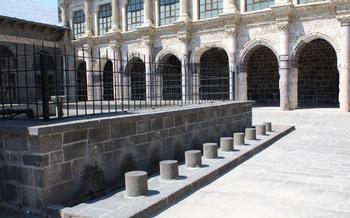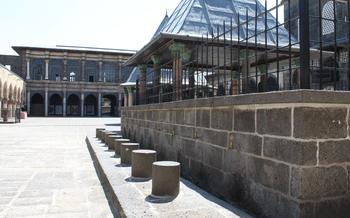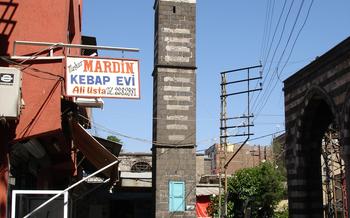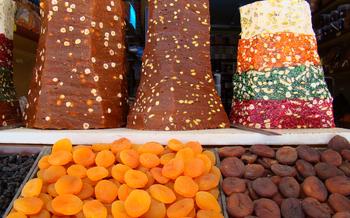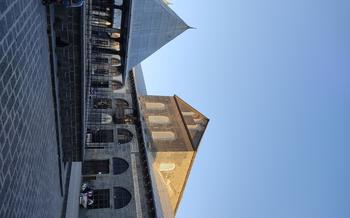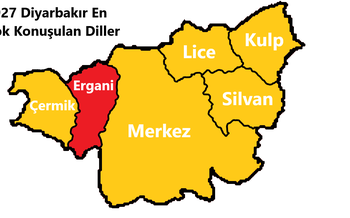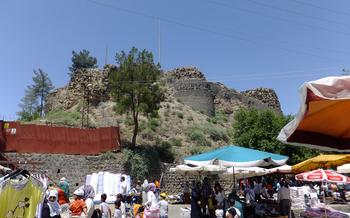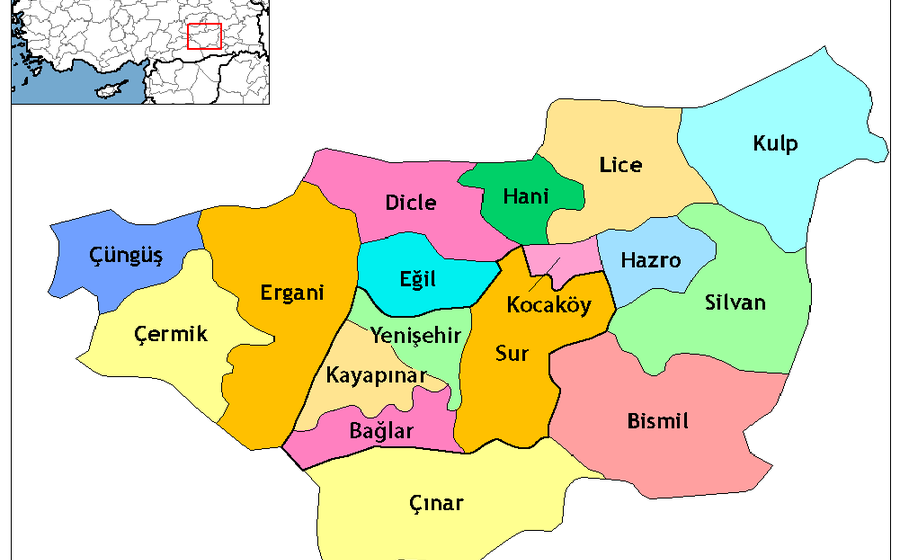
Dağkapı
- History and Cultural Significance of Dağkapı
- Encounter with a Local Historian
- Exploring İçkale
- Ulu Mosque (Grand Mosque): A Beacon of Faith and Architecture
- Diyarbakır Museum: A Journey Through History and Culture
- Sülüklü Han (Caravanserai)
- On Gözlü Köprü (Ten-Eyed Bridge)
- Sur Walls: Guardians of Diyarbakır's Past
- Ziya Gökalp Museum: Exploring the Legacy of a Turkish Sociologist
- Diyarbakır Citadel: A Symbol of Enduring Strength
- The Watermelon Festival: A Sweet Celebration
- Ferhadiye Mosque: A Masterpiece of Islamic Architecture
- History and Construction
- Architectural Features
- Cultural and Religious Significance
- Suggestion: Attend a Prayer or Religious Ceremony
- Sezai Karakoç Park
- Yenişehir District: Where Modernity Meets History
History and Cultural Significance of Dağkapı
Dağkapı, a majestic gate in Diyarbakır, stands as a testament to the city's rich history and resilience. Its origins date back to the Roman era, when it served as a vital entrance to the ancient city of Amida. Over the centuries, Dağkapı has undergone several renovations and modifications, reflecting the city's changing rulers and architectural styles. The gate's strategic position, perched atop a hill overlooking the city, made it a critical defensive point. Its imposing structure and intricate carvings showcase the craftsmanship and artistry of its builders. Dağkapı is more than just a gate; it is a symbol of Diyarbakır's enduring spirit, having witnessed the rise and fall of empires and the passage of time.
Encounter with a Local Historian
During my visit to Dağkapı, I had the privilege of meeting a local historian named Mehmet Bey. As we stood beneath the gate's towering arch, he shared captivating stories about its past. Mehmet Bey explained how Dağkapı had been the scene of numerous battles and sieges, as various armies sought to conquer Diyarbakır. He pointed out the scars on the gate's surface, left by cannonballs and catapults. Mehmet Bey's passion for his city's history was infectious, and his stories brought the gate's past to life. Through his words, I gained a deeper appreciation for the significance of Dağkapı and the resilience of the people of Diyarbakır.
Exploring İçkale
İçkale, the ancient city within the walls of Diyarbakır, is a treasure trove of history and cultural heritage. Once the heart of the city, İçkale was enclosed by the mighty Sur Walls, providing protection and seclusion. As you step through the gates of İçkale, you'll be transported back in time, surrounded by ancient structures and remnants of civilizations past.
Start your exploration with the iconic Ulu Mosque, a magnificent example of Islamic architecture that dates back to the 11th century. Marvel at its intricate carvings, towering minarets, and the serene courtyard that invites contemplation and prayer.
Within İçkale, you'll also find the remnants of the Diyarbakır Palace, once the residence of powerful rulers and dynasties. Admire the grandeur of its surviving arches, columns, and walls, which whisper tales of past glories and intrigues.
Don't miss the Church of the Virgin Mary, a testament to the city's diverse religious heritage. Step inside to admire its well-preserved frescoes and mosaics, depicting biblical scenes and stories.
For a glimpse into the city's rich cultural traditions, visit the İçkale Bazaar. Here, you can browse and shop for traditional handicrafts, textiles, jewelry, and souvenirs, while experiencing the vibrant atmosphere of a bustling marketplace.
To delve deeper into the history and stories of İçkale, consider taking a guided tour. Knowledgeable local guides will lead you through the narrow streets and alleyways, sharing insights and anecdotes that bring the ancient city to life.
Ulu Mosque (Grand Mosque): A Beacon of Faith and Architecture
Standing tall in the heart of Diyarbakır, the Ulu Mosque, also known as the Grand Mosque, is a testament to the city's rich Islamic heritage. Founded in the 11th century by the Artuqid dynasty, this sacred edifice has witnessed centuries of devotion and architectural evolution.
The mosque's striking features captivate visitors from afar. Its magnificent courtyard, adorned with intricate stone carvings and a serene fountain, sets the tone for a spiritual journey. The towering minaret, a symbol of Islamic architecture, pierces the sky, calling the faithful to prayer.
Inside, the mosque's vast prayer hall exudes an aura of tranquility and devotion. Rows of elegant columns support a series of pointed arches, creating a sense of spaciousness and grandeur. The mihrab, the sacred niche indicating the direction of Mecca, is a masterpiece of craftsmanship, adorned with intricate calligraphy and colorful tiles.
Beyond its religious significance, the Ulu Mosque serves as a center of community life in Diyarbakır. It hosts gatherings, lectures, and educational programs, fostering a sense of unity and understanding among the city's diverse population.
To fully immerse yourself in the spiritual essence of the Ulu Mosque, consider attending a prayer or religious ceremony. As the melodious call to prayer reverberates through the air, witness the devout congregation gather, their hearts and minds united in worship. This experience offers a glimpse into the deep faith and devotion that permeate the lives of Diyarbakır's people.
Diyarbakır Museum: A Journey Through History and Culture
Diyarır and the surrounding region. Its extensive collections and exhibits offer a captivating glimpse into the diverse civilizations that have shaped this ancient city.
The museum's collection spans various historical periods, from the Neolithic era to the Bronze Age, and the Islamic period. Each exhibit showcases artifacts that tell the story of Diyarbakır's vibrant past. Among the highlights are ancient pottery, intricate jewelry, and bronze figurines that provide insights into the region's early inhabitants.
Visitors can also explore displays dedicated to the Islamic period, with exhibits showcasing stunning calligraphy, ornate ceramics, and manuscripts that reflect the region's rich Islamic heritage. The museum's collection also includes exhibits on the city's diverse ethnic and religious communities, shedding light on their traditions, customs, and lifestyles.
To truly delve into the museum's treasures, consider booking a guided tour. Knowledgeable guides will provide in-depth insights into the artifacts, historical context, and cultural significance of each exhibit, ensuring a deeper understanding of Diyarbakır's rich past.
Whether you're a history buff, an art enthusiast, or simply curious about the diverse cultures that have shaped this region, a visit to Diyarbakır Museum is an absolute must. Its collections offer a fascinating journey through time, showcasing the vibrant heritage and cultural tapestry of Diyarbakır.
Sülüklü Han (Caravanserai)
In the heart of Diyarbakır's historic district, nestled amidst narrow, winding streets, stands a testament to the city's rich trading past—the Sülüklü Han, a 16th-century caravanserai. Step through its imposing arched entrance and be transported back to an era of camel caravans and bustling commerce.
The caravanserai, with its thick stone walls and intricate carvings, exudes an air of grandeur and resilience. Its central courtyard, once a haven for weary travelers and their animals, is now a vibrant hub of activity, lined with shops selling traditional handicrafts, carpets, and local delicacies.
Sülüklü Han's architectural features are a testament to the skill and artistry of its builders. The pointed arches, vaulted ceilings, and intricate stonework create a harmonious blend of aesthetics and functionality. The caravanserai's layout, with its central courtyard surrounded by rooms and stables, allowed for efficient movement of goods and the safekeeping of animals.
Today, Sülüklü Han has been lovingly restored and repurposed, retaining its historical charm while adapting to modern needs. It now houses a variety of shops, cafes, and cultural venues, making it a popular destination for both locals and visitors.
In the evening, the courtyard transforms into a magical setting, illuminated by lanterns and the gentle murmur of conversation. Visitors can savor traditional Kurdish dishes at one of the many restaurants, sip on aromatic Turkish coffee, or delve into the history of the caravanserai at the on-site museum.
On Gözlü Köprü (Ten-Eyed Bridge)
Dating back to the Roman period, the On Gözlü Köprü, or Ten-Eyed Bridge, stands as a testament to Diyarbakır's rich architectural heritage. Constructed over the Tigris River, this remarkable bridge boasts ten arches, each meticulously designed to withstand the river's powerful currents. Its strategic location served as a vital crossing point for trade and travel, connecting the city with the surrounding regions.
Admire the bridge's impressive stonework, showcasing the engineering prowess of ancient Roman builders. The arches, rising gracefully above the river's surface, create a mesmerizing rhythm that draws the eye. As you stroll along the bridge, take a moment to appreciate the intricate carvings and decorative elements that adorn its facade, each telling a story of the city's past.
In the evening, the bridge transforms into a magical spectacle as the setting sun casts a warm glow on its ancient stones. The lights reflecting on the water's surface create a shimmering effect, making it a perfect spot to capture some stunning photographs. Whether you choose to visit during the day or night, the On Gözlü Köprü is an unmissable landmark that offers a glimpse into Diyarbakır's enduring legacy.
Suggestion:
For an unforgettable experience, visit the bridge during sunset. The golden hues of the sky beautifully illuminate the bridge's arches, creating a breathtaking backdrop for your photographs. As the sun dips below the horizon, the bridge takes on a mystical aura, making it the perfect place to soak in the city's tranquil atmosphere.
Sur Walls: Guardians of Diyarbakır's Past
The Sur Walls, a towering testament to Diyarbakır's resilience, stand as a symbol of the city's rich history. Erected during the Roman period, these colossal fortifications have borne witness to countless battles and sieges, safeguarding the city's inhabitants from invaders throughout the ages. Constructed with precision and ingenuity, the walls feature massive stone blocks, intricate carvings, and imposing towers, showcasing the architectural prowess of their ancient builders.
Their strategic placement atop a rocky outcrop overlooking the Tigris River provided a natural defense, making Diyarbakır virtually impregnable. The walls, with their impressive height and thickness, served as an insurmountable barrier, deterring potential attackers. The intricate network of gates and tunnels allowed for controlled access and facilitated the movement of troops and supplies within the city.
Over the centuries, the Sur Walls have undergone numerous renovations and modifications, reflecting the evolving needs and influences of successive civilizations. Islamic motifs and architectural elements were incorporated, blending seamlessly with the original Roman foundations. Today, these majestic walls stand as a testament to Diyarbakır's enduring spirit, a symbol of its resilience and a reminder of the city's profound historical significance.
Suggestion: Walk the Walls for a Journey Through Time
For an immersive experience, embark on a leisurely walk along the Sur Walls, taking in the panoramic views of the city and its surroundings. As you stroll atop these ancient fortifications, imagine the footsteps of soldiers and traders who once traversed these same stones. Each step unveils a chapter in Diyarbakır's rich history, providing a tangible connection to the past. Let the walls transport you back in time, as you marvel at their grandeur and the stories they hold within.
Ziya Gökalp Museum: Exploring the Legacy of a Turkish Sociologist
The Ziya Gökalp Museum, located in the heart of Diyarbakır, offers a glimpse into the life and contributions of one of Turkey's most renowned sociologists and writers, Ziya Gökalp. Established in 1972, the museum houses a collection of artifacts, documents, and personal belongings that shed light on Gökalp's significant role in shaping Turkish thought and identity.
Through interactive exhibits and displays, visitors can learn about Gökalp's early life, education, and his involvement in the intellectual and political movements of the late 19th and early 20th centuries. The museum showcases his writings, lectures, and contributions to sociology, literature, and Turkish nationalism.
One of the highlights of the museum is a recreation of Gökalp's study, complete with his desk, books, and personal items. Visitors can almost feel the presence of this influential thinker as they immerse themselves in his intellectual world.
The Ziya Gökalp Museum is not just a repository of historical artifacts but also a place where his ideas and legacy continue to be discussed and debated. The museum regularly hosts lectures, seminars, and discussions on Gökalp's work and its relevance to contemporary society.
Anecdote: A Thought-Provoking Conversation
During my visit to the Ziya Gökalp Museum, I had the opportunity to attend a lecture by a renowned scholar who discussed Gökalp's ideas on Turkish nationalism and cultural identity. The lecture sparked a thought-provoking conversation among the audience, exploring the complexities of Gökalp's theories and their impact on modern Turkey.
The experience reminded me of the enduring influence of Ziya Gökalp's work. His ideas continue to inspire and challenge thinkers, scholars, and policymakers even today, making the Ziya Gökalp Museum a must-visit for anyone interested in Turkish history, culture, and identity.
Diyarbakır Citadel: A Symbol of Enduring Strength
Diyarbakır Citadel, a symbol of the city's rich heritage, stands as a testament to its enduring strength and resilience. Its imposing presence, with its towering walls and monumental gateways, evokes a sense of awe and wonder. Built in the 4th century AD by the Romans, the citadel has witnessed countless battles and sieges throughout history, serving as a strategic stronghold and a center of power.
The citadel's architectural features are a marvel to behold. Its massive walls, constructed with precision and ingenuity, have withstood the test of time. The intricate carvings and decorative elements adorning the gates and towers showcase the artistic prowess of its builders. Inside the citadel, visitors can explore a labyrinth of narrow streets, courtyards, and hidden chambers, each revealing a glimpse into the citadel's fascinating past.
Throughout history, the citadel has served as a military and administrative center, housing garrisons, government offices, and royal residences. Its strategic location, atop a hill overlooking the city, provided a commanding view of the surrounding landscape, making it an ideal defensive position. The citadel's impregnable walls and fortifications made it a formidable barrier against invaders, ensuring the city's safety and security.
Today, the citadel stands as a living museum, inviting visitors to journey through its storied past. Within its walls, a museum showcases artifacts and exhibits that narrate the citadel's rich history and its role in shaping the destiny of Diyarbakır. Visitors can wander through the citadel's grounds, marveling at its architectural grandeur and imagining the echoes of history that linger within its walls.
Suggestion: Visiting the citadel's museum is a must for anyone seeking a deeper understanding of Diyarbakır's heritage. The exhibits and artifacts provide a comprehensive account of the citadel's construction, its military significance, and its role as a center of power throughout the ages.
The Watermelon Festival: A Sweet Celebration
The annual Watermelon Festival in Diyarbakır is a vibrant celebration that pays homage to the city's love for this refreshing fruit. With roots dating back to the 1950s, the festival has become a beloved tradition that attracts locals and visitors alike.
During the festival, the streets of Diyarbakır come alive with festivities, events, and competitions. The highlight of the festival is the watermelon-eating contest, where participants race against time to devour as many slices of watermelon as possible. The festival also features live music, traditional dance performances, and family-friendly activities.
Watermelons hold a special place in Diyarbakır's cuisine and tradition. The city's fertile soil produces some of the sweetest and juiciest watermelons in the region. Locals take pride in their watermelons and often incorporate them into their daily meals and desserts.
Participating in the Watermelon Festival is a delightful way to immerse yourself in Diyarbakır's culture and traditions. Whether you're competing in the eating contest, enjoying the live entertainment, or simply savoring the delicious watermelon treats, you're sure to have a memorable and sweet experience.
Insider Tip:
To make the most of your Watermelon Festival experience, be sure to try the local watermelon ice cream, a refreshing treat that perfectly captures the essence of this beloved fruit.
Ferhadiye Mosque: A Masterpiece of Islamic Architecture
Standing tall in the heart of Diyarbakır, the Ferhadiye Mosque is a testament to the city's rich architectural heritage. Built in the 16th century during the reign of the Ottoman Sultan Süleyman the Magnificent, this magnificent mosque showcases a harmonious blend of Islamic and Anatolian architectural styles.
History and Construction
The Ferhadiye Mosque was commissioned by Ferhad Pasha, a prominent Ottoman governor of Diyarbakır, who is believed to have been the son-in-law of Sultan Süleyman. The mosque was constructed over several years, with its completion marking a significant milestone in the city's urban development.
Architectural Features
The Ferhadiye Mosque boasts several unique architectural features that distinguish it from other mosques in the region. Its most striking characteristic is its massive dome, which dominates the city skyline. The dome is supported by four massive pillars, each adorned with intricate carvings and calligraphy.
The mosque's exterior is adorned with beautiful stonework, featuring geometric patterns and floral motifs. The entrance portal, known as the "pishtak," is particularly impressive, with its elaborate carvings and inscriptions.
Cultural and Religious Significance
The Ferhadiye Mosque holds deep cultural and religious significance for the people of Diyarbakır. It is considered one of the most important mosques in the city and is a popular destination for both locals and tourists.
The mosque is not only a place of worship but also a center for community gatherings and religious education. It hosts regular prayer services, Quranic recitations, and Islamic lectures, fostering a sense of unity and spirituality among the faithful.
Suggestion: Attend a Prayer or Religious Ceremony
To truly experience the spiritual essence of the Ferhadiye Mosque, it is recommended to attend a prayer or religious ceremony held within its hallowed walls. Visitors can witness the devotion and tranquility that permeate the mosque during these sacred gatherings, gaining a deeper understanding of the role of Islam in the daily lives of Diyarbakır's people.
Sezai Karakoç Park
Named after the renowned Turkish poet Sezai Karakoç, this park is a tranquil oasis amidst the bustling city. Established in 1996, it offers a sanctuary for relaxation and recreation. With its lush green spaces, well-manicured gardens, and shaded walkways, the park provides a welcome respite from the urban heat and chaos.
Visitors can stroll along the paved paths, admiring the colorful flower beds and ornamental trees that adorn the park. There are plenty of benches and seating areas where one can sit and soak in the peaceful ambiance. For those seeking active pursuits, the park features a playground for children, as well as basketball and tennis courts.
Sezai Karakoç Park also serves as a cultural hub, hosting various events and activities throughout the year. Poetry readings, art exhibitions, and musical performances are just a few examples of the cultural offerings that take place in the park. It's a popular gathering spot for locals and tourists alike, who come to enjoy the park's serene atmosphere and vibrant cultural scene.
Insider Tip:
For a truly unique experience, visit the park during the annual Sezai Karakoç Poetry Festival. Held in the poet's honor, the festival features recitals, workshops, and discussions on poetry and literature. It's an excellent opportunity to immerse yourself in the world of poetry and celebrate the legacy of one of Turkey's most beloved poets.
Yenişehir District: Where Modernity Meets History
Diyarbakır's Yenişehir district stands as a testament to the city's ability to embrace modernity while preserving its rich heritage. Once a quiet residential area, Yenişehir has transformed into a vibrant hub of activity, attracting locals and visitors alike.
At the heart of the district lies the bustling Kayapınar Bazaar, a shopper's paradise offering a diverse range of goods, from traditional textiles to modern electronics. The district is also home to several shopping malls, including the impressive Diyarbakır Park AVM, which houses a mix of international and local brands.
In the evenings, Yenişehir comes alive with a vibrant nightlife scene. The district's numerous restaurants, cafes, and bars offer a variety of culinary experiences and entertainment options. From traditional Kurdish cuisine to international fare, there's something to satisfy every palate.
For those seeking a more cultural experience, Yenişehir also boasts several theaters, cinemas, and art galleries. The Diyarbakır State Theater, located in the heart of the district, stages regular performances, showcasing the talents of local and national artists.
Whether you're a history buff, a shopaholic, or simply looking for a fun night out, Yenişehir district has something for everyone. Its unique blend of modernity and tradition makes it a must-visit destination for any traveler exploring Diyarbakır.
